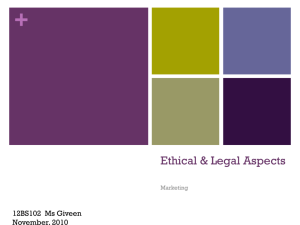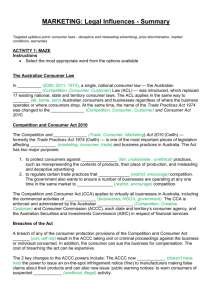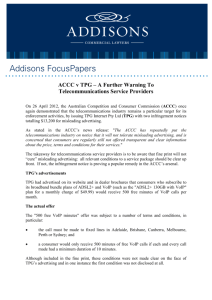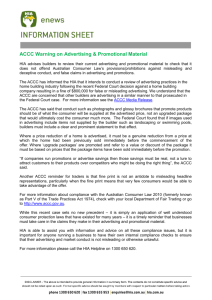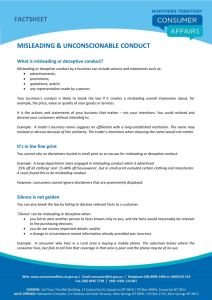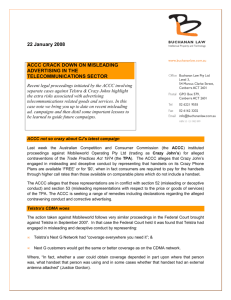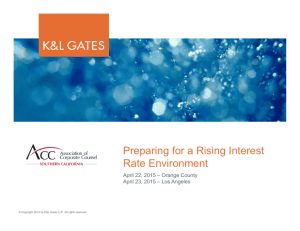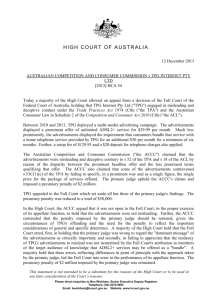presentation
advertisement
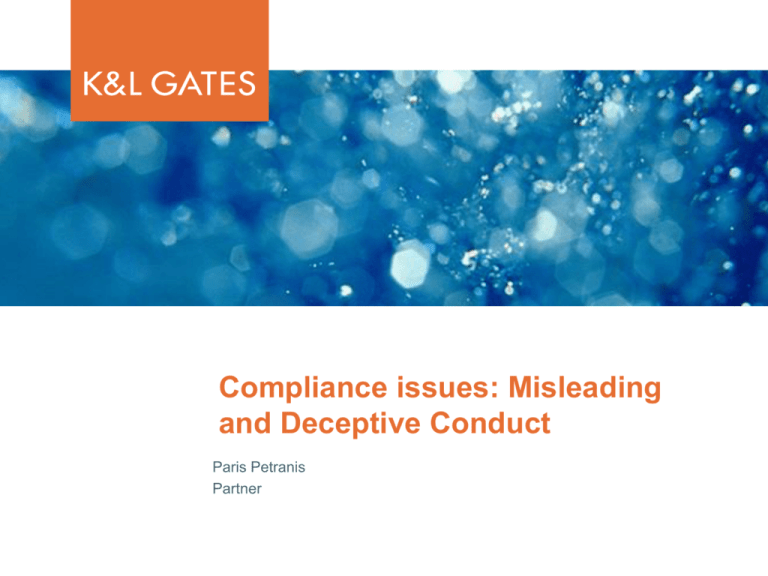
Compliance issues: Misleading and Deceptive Conduct Paris Petranis Partner WHAT’S THE BIG DEAL? “Cartel conduct in government procurement, truth in advertising, competition and consumer issues in the health sector and industry codes are some of the Australian Competition and Consumer Commission’s new compliance and enforcement priorities for 2015” (ACCC media release 19 February 2015 – emphasis added) klgates.com 2 WHAT’S THE BIG DEAL? (CONT) “This year we will begin a new program of reviews of selected industry sectors. The sectors we are currently reviewing include debt collection and private health insurance” “These reviews will assist us to identify risks to consumers and the competitive process that may require intervention, and possibly identify and encourage good industry practice” (Rod Sims, ACCC Chairman, 19 February 2015) klgates.com 3 WHAT’S THE BIG DEAL? (CONT) NIB paid a penalty of $10,200 following the issue of an Infringement Notice by the Australian Competition and Consumer Commission in relation to advertising about the waiver of the waiting period for “Extras” cover. From December 2012 to November 2014, in promoting its combined Hospital and Extras cover, NIB offered to waive the waiting period on its Extras option which it represented as “usually” or “normally” requiring a 2 month wait. klgates.com 4 MISLEADING AND DECEPTIVE CONDUCT Schedule 2 of the Competition and Consumer Act 2010 (Cth) (ACL) Main source of consumer protection We will focus on misleading and deceptive conduct PHI Code of Conduct emphasises the requirement to comply with the Competition and Consumer Act 2010 (Cth) klgates.com 5 MISLEADING AND DECEPTIVE CONDUCT (CONT) A person must not, in trade or commerce, engage in conduct that is misleading or deceptive or is likely to mislead or deceive (section 18 ACL) klgates.com 6 MISLEADING AND DECEPTIVE CONDUCT (CONT) We will cover: Misleading and deceptive conduct generally Disclaimers (fine print) Comparative advertising Puffery klgates.com 7 MISLEADING AND DECEPTIVE CONDUCT (CONT) Do not make any statements in business which are: Misleading or deceptive; or Likely to mislead or deceive – a real or not remote chance or possibility regardless of whether it is less or more than 50% Every statement you make must be true and accurate in all material respects klgates.com 8 MISLEADING AND DECEPTIVE CONDUCT (CONT) Prohibition applies to all: Product disclosure statements (SIS) Statements made (whether oral or written) Advertising, marketing or promotional material Terms of sale Discussions with members and potential members Contract negotiations Business communications klgates.com 9 MISLEADING AND DECEPTIVE CONDUCT (CONT) Intent is irrelevant - all that is relevant is whether, tested objectively, the conduct is misleading or deceptive or likely to be so Misleading or deceptive conduct occurs at the time when the conduct occurs or is published Later clarifications do not overcome earlier misleading or deceptive conduct klgates.com 10 MISLEADING AND DECEPTIVE CONDUCT (CONT) Assessed by reference to the audience The astute and the gullible, the intelligent and not so intelligent, the well educated and the poorly educated Tip - someone who has less than average intelligence but is not “extremely stupid or gullible” Tip - Not someone who works for a private health insurer or has a keen interest in private health insurance klgates.com 11 MISLEADING AND DECEPTIVE CONDUCT (CONT) Must be in trade or commerce Silence itself may be misleading or deceptive: Leaving out (or hiding) important information Not correcting a misunderstanding Hypothetical example: A PHI employee sells a PHI policy to a pregnant lady (who makes it clear her main concern is maternity care) without telling her there is a 12month waiting period for obstetrics klgates.com 12 MISLEADING AND DECEPTIVE CONDUCT (CONT) Overall impression is the key Ad will be judged by its first and overall impression Overall impression of an ad can be misleading even if it contains factually correct statements klgates.com 13 DISCLAIMERS Disclaimers cannot be used to correct a misleading claim in the body of an ad or document Fine print must not contradict main message or overall impression Must be specific, clear and highly visible (size does matter) klgates.com 14 DISCLAIMERS (CONT) Should be proximate to the material being disclaimed and presented at the same time as the claim On same page / webpage (not click through) Not at end of TV or radio ad when item being disclaimed was referenced at start of ad Should only be used to provide additional information klgates.com 15 DISCLAIMERS (CONT) “Conditions apply” may not be good enough Unacceptable not to disclose relevant terms because of lack of space or because “disclaimers are ugly” A television advertisement advertising that on weekends local calls were free was found misleading notwithstanding a prompt which stated “Some exclusions apply” (TPC v Optus) klgates.com 16 ACCC QUOTES "The inclusion of an asterisk or a fine print disclaimer does not remove the potential for a headline to be misleading“ "Companies must ensure that they do not use misleading headlines about the price and other key terms and conditions of the services being offered. It is not enough for a company to try to correct a misleading headline using fine print text“ "The advertising practice of fine-print qualification is one the ACCC is tired of correcting" "The ACCC will take an increasingly aggressive approach to send the message that this kind of misleading advertising will not be tolerated" klgates.com 17 RECAP Overall impression is critical Disclaimers aren’t a “cure all” ACCC will look to the message concerned regardless of the medium in which it is delivered (ie, you get no grace because there is limited space on a billboard or limited time on a TV ad) klgates.com 18 COMPARATIVE ADVERTISING Comparisons with competitors inherently risky! Not because there is a higher burden to show accuracy But because Errors in comparative advertising may have a greater potential to mislead Competitors more likely to notice and/or challenge potentially misleading claims klgates.com 19 COMPARATIVE ADVERTISING (CONT) When comparing products in advertisements, your product must be compared with your competitor’s most directly comparable product, i.e. “like for like” (How can you do this????) All main assumptions and factual matters relating to the comparison must be disclosed klgates.com 20 COMPARATIVE ADVERTISING – EXAMPLE (CONT) Example: Duracell bunny Up to “3 times longer” But – comparing (expensive) alkaline battery to (cheaper) zinc carbon battery Also not disclosing Eveready alkaline battery durability similar to Duracell Federal court held ad misleading klgates.com 21 COMPARATIVE ADVERTISING (CONT) No control over what your competitor does. They may change offering and render your advertising incorrect and misleading No grace period for changes to competitor offering klgates.com 22 COMPARATIVE ADVERTISING (CONT) Potential for unintentional comparisons “only” “better/best” Can be implicit comparison klgates.com 23 COMPARATIVE ADVERTISING (CONT) Tip: Invite the consumer to make the comparison “Does your health cover offer all of this?” Tip: Remember overall impression Tip: Watch for unintentional comparisons and for inappropriate implications klgates.com 24 COMPARATIVE ADVERTISING (EXAMPLE) Telstra v Optus (2014) Visual: Map of Australia (with graphics – 98.5% cf 99.3%) Voiceover: “When it comes to the percentage of Australians the Optus mobile network reaches, there isn’t much difference between us and Telstra. In fact, it’s less than 1%.” Supreme Court of Victoria held the advertisement was misleading as consumer could have construed the percentage coverage to reflect geographic coverage klgates.com 25 PUFFERY Marketing hype – exaggeration, superlatives “great value” ACL makes no distinction between representations and puffery – although this does not mean courts will regard all puffery as misleading “In the ordinary course of commercial dealings, a certain degree of ‘puffing’ or exaggeration is to be expected” klgates.com 26 PUFFERY (CONT) The more a statement is capable of being objectively assessed, the less likely it will be considered puffery “Lowest price”? Context is relevant Case example: “World’s longest lasting battery in high powered devices” – not puffery klgates.com 27 CASE EXAMPLE: ACCC V TPG Federal Court single judge decision: Decision – 4 November 2011 Penalties – 15 June 2012 Full Federal Court appeal: Decision – 20 Dec 2012 Penalties – 4 Apr 2013 High Court: Decision – 12 Dec 2013 Facts: See following ad klgates.com 28 CASE EXAMPLE: ACCC V TPG (CONT) klgates.com 29 CASE EXAMPLE: ACCC V TPG (CONT) Trial: TPG engaged in conduct that was misleading or deceptive or likely to mislead or deceive TPG made false or misleading representations in relation to the price of the services klgates.com 30 CASE EXAMPLE: ACCC V TPG (CONT) Trial: Findings made because the advertisement did not prominently specify that the offer was conditional on a customer: Paying to TPG a total of no less than $59.99 per month Purchasing, or bundling, home telephone line rental with broadband internet service for an extra $30 Dominant message was “Unlimited ADSL2+ for $29.99 per month” klgates.com 31 CASE EXAMPLE: ACCC V TPG (CONT) Trial: Bundling condition “tends to seriously undermine the integrity of the dominant message, contradicting rather than fairly qualifying it” klgates.com 32 CASE EXAMPLE: ACCC V TPG (CONT) Trial – Penalties: $1.4M pecuniary penalty for ads similar to the internet ad ($2M penalty overall) TPG at its own expense to: Publish corrective ads in state and national newspapers and on its website Mail corrective ads to each person who became a customer between 25/9/2010 – 2/12/2011 klgates.com 33 CASE EXAMPLE: ACCC V TPG (CONT) Trial – Penalties (cont): Injunctions restraining similar conduct for 3 years TPG to maintain and administer a trade practices compliance program for 3 years TPG to pay the ACCC’s costs klgates.com 34 CASE EXAMPLE: ACCC V TPG (CONT) Trial – Penalties (cont): In framing the penalties, court took into account the fact that prior to issuing the ad, TPG considered and rejected using the following advertisement which clearly sets out the $59.99 monthly price klgates.com 35 CASE EXAMPLE: ACCC V TPG (CONT) klgates.com 36 CASE EXAMPLE: ACCC V TPG (CONT) FULL COURT APPEAL Allowed TPG’s appeal in part Only the initial TV ads which ran for 12 days before being revised were misleading None of the other ads were misleading Reduced the trial judge’s penalty orders from $2 million to $50,000 ($125,000 appropriate) Orders for injunction, corrective advertising and compliance program also set aside ACCC ordered to pay 75% of TPG's costs klgates.com 37 CASE EXAMPLE: ACCC V TPG (CONT) FULL COURT APPEAL Issue: Was the bundling condition and set up fees sufficiently prominent to prevent the “Unlimited ADSL2+ for $29.99 per month” statement from being misleading? Principle: look at the whole ad in its full context, and not just the dominant message conveyed In this case: full context included consumer knowledge about "the “bundling” method of sale commonly employed with this type of service, as well as knowledge that set up charges are often applied" klgates.com 38 CASE EXAMPLE: ACCC V TPG (CONT) FULL COURT APPEAL Other ads were not misleading: Bundling requirement and set up charges could be seen and heard and were sufficiently prominent An ordinary or reasonable consumer would have known of the commercial practices of bundling and set up charges The ACL does not operate for the benefit of consumers who fail to take care of their own interests, including those who do not pay attention to the whole ad klgates.com 39 CASE EXAMPLE: ACCC V TPG (CONT) HIGH COURT APPEAL ACCC appealed to the High Court Majority (4 out of 5) overturned FFC's findings and held that: all of TPG's advertisements were misleading FFC erred in finding that: home telephone bundling requirement and set up charges were adequately disclosed consumers would have known that internet services were commonly bundled with telephone services klgates.com 40 CASE EXAMPLE: ACCC V TPG (CONT) HIGH COURT APPEAL Reasoning of majority: dominant message ("Unlimited ADSL2+ for $29.99 per month“) was of crucial importance and was false ads had a tendency to mislead consumers because they selected some words for emphasis and relegated the balance to relative obscurity tendency to mislead: not neutralised by consumer knowledge that internet services may be bundled determined by asking whether ads would cause customers to engage TPG rather than with competitors based on an erroneous belief engendered by dominant message klgates.com 41 CASE EXAMPLE: ACCC V TPG (CONT) HIGH COURT APPEAL Penalties: Overturned FFC’s order to pay $50,000 penalty Reinstated $2 million penalty ordered by trial judge Important comments: “[T]hose engaged in trade and commerce must be deterred from the cynical calculation involved in weighing up the risk of penalty against the profits to be made from contravention.” “High Court recognised that penalties must be fixed with a view to ensuring that the penalty is not such as to be regarded by businesses as an acceptable cost of doing business." klgates.com 42 TAKE AWAY When drafting any business document (particularly any promotional material), ask yourself: What type of person will read the document or hear the claim? Will that type of person understand your claim? Can you prove that every word is true? Is the overall impression accurate? Has an important fact(s) been left out? klgates.com 43 QUESTIONS? Further information Paris Petranis 03 9205 2014 paris.petranis@klgates.com klgates.com 44
